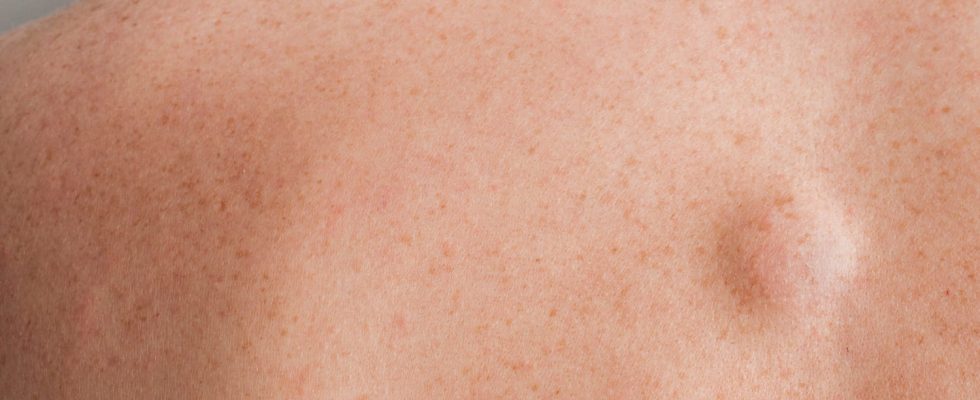A lipoma is a ball of fat that develops under the skin, on the arms, neck, torso, and sometimes on the back. Normal or cancerous?
A lipoma is a grease ball which develops under the skin. This is generally a benign tumor but in some cases it can develop into a cancerous tumor. Explanations with our dermatologist.
Definition: what is a lipoma?
Lipomas are fat balls 5 to 7 cm in diameter which form under the epidermis by the agglomeration of fat globules. This happens when certain cells in the fatty tissue proliferate so much that they eventually form a lump, called a lipoma. “It is therefore a tumor, benign in the vast majority of cases“, explains Dr Marie Estelle Roux, dermatologist. We don’t really know their origin, they appear on different parts of the body, especially on the arms, neck, torso or breast. There are three main types of lipomas:
- THE circumscribed lipoma (appearing under the skin or in a muscle),
- THE diffuse lipoma (much rarer, similar to a benign tumor),
- adenolipomatosis (which designates a lipoma associated with underlying lymphadenopathy, located in a lymph node).
These tumors mainly affect adults between 40 and 60 years old. We sometimes wrongly speak of a “fatty cyst” to refer to a lipoma. Gold “LThe term “fatty cyst” is not a medical term, when it is fatty, we are therefore not talking about a cyst, but a lipoma “, explains the dermatologist.
The lipoma is often located at the level of the shoulder girdle (both shoulder blades and both clavicles) and arms, but it can also be located on the breasts, face or legs. Lipoma does not cause no symptoms. They may remain for a while before their existence is detected, unless they are in an unsightly location. They are therefore diagnosed by palpation. They can sometimes cause pain if they develop near a nerve, or if, in very rare cases, the tumor becomes cancerous.
“If the lipoma changes appearance, grows, becomes hard or painful, it may be cancerous”
What are the causes of a lipoma?
“Their origin is often unexplained“, explains Dr Marie Estelle Roux, there may be genetic predispositionsor they may appear following a shockfor example on the forehead when a patient bumped“. If they are often crushing, they can worry some patients who confuse them with a malignant tumor.
Lipomas generally do not cause any complications., in the vast majority of cases they are benign. “If the doctor has any doubt, a clinical examination will be able to tell whether it is a benign or cancerous tumor.“, specifies Dr Marie Estelle Roux. “It’s here consistency and mobility of the lipoma which indicate its nature. If the lipoma changes appearance, grows, becomes hard or painful, it may be cancerous and you should therefore consult, but this is a very rare situation.“.
It is possible to remove lipomas by liposuction (fat suction) or by surgical removal. Lipoma resection is indicated only when his situation is embarrassing for the individual : to know “when it causes pain, functional or aesthetic discomfort, but also when the doctor has doubts about the benign nature“, details Marie Estelle Roux. So, how to choose between liposuction and surgery? “It’s on a case by case basis“, explains the dermatologist. “There liposuction allows for a quick, scar-free operation.“It is therefore recommended for small lipomas. As for surgery“this alone guarantees that there will be no recurrence, because only by operating can we be completely sure of removing the entire tumor. But it creates a scar as large as the size of the lipoma“. Reimbursement for the operation depends on its reason for being. If it is purely aesthetic, it is not covered. On the other hand, if it is a medical necessity, Social Security reimburses part of its costand the mutual completes the reimbursement according to the subscribed rate.
Thanks to Dr Marie Estelle Roux, dermatologist.
